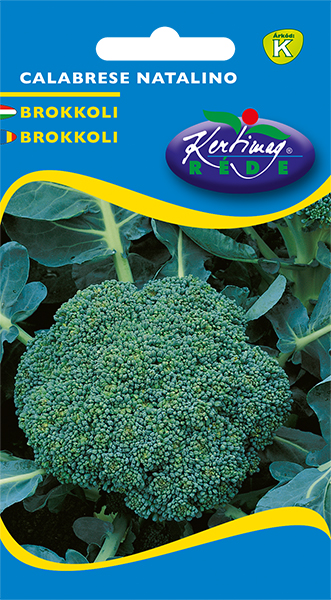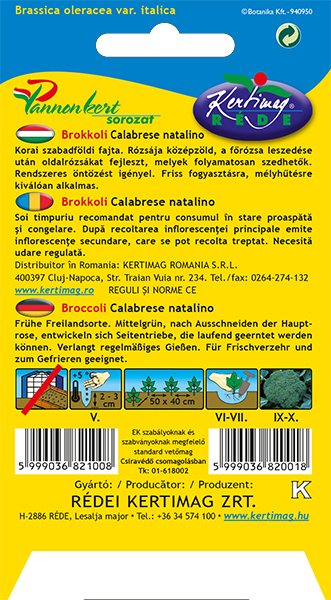Broccoli Calabrese 2g
| HUF 326 * (nettó: HUF 257) | |
Characteristics of Broccoli:
Annual plant. It is an annual. Its taproot penetrates the soil at a medium depth (50-60 cm). Just below the soil surface, it is already densely branched. It penetrates the upper 20-30 cm of the soil and is therefore sensitive to drought. Its leaves and flower formation are very similar to cauliflower. The leaves are arranged in a spreading arrangement on straight, slightly fleshy stems. The stalk is 40-70 cm long, more than a cauliflower. It has an elongated shoot axis, divided in the upper third into several fleshy flowering branches. The petiole is shorter than the leaf blade. The bright bluish-green colour of the leaves is interspersed with a thick network of thick main veins and bright greenish-white lateral veins. The lower leaves are slightly fleshy and the upper ones are lanceolate, while the upper ones are very short-necked or sessile. The leaf blade is elongated, often irregularly ovate, with a smooth surface.
The head, which will become the inflorescence, begins to form with a small growing cone when the plant is 8-9 leaves old. From the first stage of head formation until flowering, the growing cone is indistinguishable from the stem, remaining bluish green throughout. At the time of technical ripening (picking), the head consists of amain branch, which ends in the central tepals, on which the first-order axes and branches develop. Each axis ends in the same growing cone and branches into a second branch, which continues into a third, fourth, etc. The series of branches can extend up to the sixth or seventh order. The lower shoots are more highly branched than the upper ones, the number of branches per level varying from 60 to 20, taking into account that the head sometimes has 70 to 80, perhaps 100 first-order shoots, the branching system is very complex.
If all the shoots of a broccoli head were to sprout into seeds, they would produce a huge number of flowers (20-30 times more than the average head of cabbage). A significant proportion of the shoots die during flower head formation, with up to 80% of the first-order shoots dying. Fruiting occurs mainly on the fourth to fifth-order shoots. However, the rate of shoot dieback is much lower than that of cauliflower, proving that broccoli is still in a much wilder state.
Some of the short shoots will slip into seed stalks and produce a budding inflorescence, while others will atrophy or gradually die back. The flower structure, flowering, fruit and seeds are similar to those of other cabbages of the crucifer family (buddleia, Chinese kale, etc.).
Environmental requirements of broccoli
Heat requirements
Not a heat-demanding crop. It requires most heat at germination, 18-22 °C. For growth, temperatures of around 15-20 °C are sufficient. Unlike cauliflower, it tolerates high temperatures even when in bud. It tolerates cold temperatures and can withstand frosts of a few degrees without any particular damage. Cool, rainy weather and air with high humidity are best. In hot weather, side shoots are slowed down and yields are reduced.
Light requirements
It has a medium light requirement. It grows evenly in cloudy, sunless summers and produces a nice big head. It does not need to be protected from strong, scorching sunlight, as it is not sensitive to light. It can also be grown in light shade.
Water requirements
It has a very high water requirement. Its roots only penetrate the top layer of the soil and therefore it cannot absorb water from deep down. It requires permanently moist soil. When the soil dries out, growth stalls and is difficult to restart. It needs particularly much water during the budding period. Depending on the weather, water the most important thing, water, in 3-7 day watering cycles.
Soil requirements
It prefers soils with a friable texture and good water management. Experiment with growing in loose soil only if irrigation is available. It grows well in riverine soils where the water table is high enough. It can be grown in slightly acidic or inert soils. It can be grown in monoculture, i.e. planted in the same place for a few years, in soils with high water content.
Nutrient requirements
High nutrient demand. The high humus content is very favourable for broccoli and has a positive effect on yield. If the soil does not contain sufficient organic matter, apply organic fertiliser in large quantities (30-40 kg/10m2). The other part of the broccoli's nutrient requirements should be supplied as fertiliser. It is particularly important to satisfy its high nitrogen demand. Apply 40 dkg of pesticideper 10m2 as a base fertiliser and 40-50 dkg of pesticide for top dressing. It is recommended to apply the base fertilizer 1-2 weeks before planting and the top dressing 2-3 times. It needs a lot of nitrogen when the rose heads are maturing and when the lateral heads are forming. Among other inorganic materials, superphosphate and potash should be added at a rate of 40-50 dkgper 10m2, and in addition, possible boron and molybdenum deficiencies may cause problems.
Growing broccoli:
Due to its short growing season, it is only sporadically grown as a second crop in our country. It can be propagated by direct sowing and by planting, the latter being the more common.
For seedling production, seeds can be sown in the open ground in cold beds from the end of May, ready for planting in July. The less frequent sowing of 400 to 500 plantsper m2 will produce more beautiful and healthier seedlings. When growing seedlings, try to ensure that growth is continuous.
Before planting, remove the remains of the previous plant and scarify the area, then rake immediately to a smooth surface. Then mark out the rows 60-70 cm apart, planting the stems 40-50 cm apart within the rows. After planting, saturate the soil between the roots with water.
Watering and weeding is a mid-year maintenance job. The coordination of the two is very important, because timely weeding is equivalent to watering. During the period of intensive head formation (end of August), it is essential to head weed.
Harvesting requires some practice, so initially cut the head off earlier than the buds open. From the cut heads, use a scissors to pinch out any flowers that have opened accidentally. The buds are picked with a sharp knife with a stalk of 20-25 cm. After cutting off the ends of the main shoots, the side shoots form small but usable heads, so do not stop watering.
Harvesting can be delayed by sowing or transplanting later until after severe frosts, and some varieties can even be overwintered in milder winters.
They have no pests or pathogens of their own, only occasional aphid infestations can be a problem.
Use
Similar to cauliflower in both cultivation and use. The cut heads can be used with the stalk, which is about 20 cm long. If the stem part is old, cut it back more or peel it. Like the stalk, it has a very high mineral content, especially potassium. Its vitamin C content is particularly high, approaching that of green peppers and parsley, and its carotene content should not be underestimated. It can be used both fresh and frozen. It could be particularly important in winter, to add to the range of vegetables available at the end of the winter. Thick, fleshy stems are a delicious delicacy raw.
| Weight: | 0.003 kg |
|---|---|
| Width: | 140 mm |
| Height: | 80 mm |
| Length: | 1 mm |
| Aviability: | 1-4 nap |
| Basic sales unit: | db |
| Culture: | Zöldség |
Login
Login

